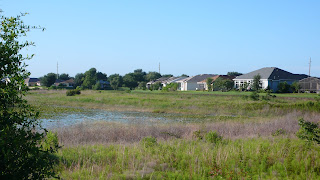Important:
1. The restoration of the scrub jay habitat is a mandate by regulatory agencies and needs to be incorporated in the regular maintenance plan for the community.
2. All proposals below need the cooperation of the BOD, the CAM, and ENC. The expertise of our landscaping company will be necessary.
Phase 1: Clean-up
1. Mow Bahia grass in areas 2, 3 , and 4. Area 3 is easiest because it is the smallest and its borders are clearly visible.
2. Mow Bahia grass in
one part of area. Volunteers will delineate area with stakes and string.
3. Most mowing needs to be done with narrow machines and under supervision because the scrub oaks are too small to be seen by someone riding on a wide machine.
4. Remove blackberry and other bushes that encroach on the remaining scrub oaks.
Phase 2: Restore
1. Remove several patches of Bahai grass and add sand in areas 1, 2,3, and 4. Volunteers will assist.
2. Add sand live oaks and other scrub oaks in specific areas to be indicated by Jay Watch volunteers from Legacy. This can be done in phases. Sand live oaks look like small live oaks and are just as beautiful. To see three kinds of scrub oaks, please visit PEAR Park's restoration area.
Phase 3: Maintain
Include the habitats and the additional scrub oaks in the enhancement areas in the regular maintenance plan for our community.


 PEAR Park lies across from Legacy on the other side of 27. To entice the scrub jays living in the adjacent neighborhood of Plantation, where they find an atypical habitat, PEAR Park's volunteers established a scrub habitat. They hope that the youngsters of remaining families will branch off into their own clan. So far, the scrub jays have come to check it out, but they haven't stayed yet. Above, three typical scrub oaks: Chapman, sand live and myrtle oak. The bird's favorite nesting tree is the sand live oak which looks like a small live oak when it is a bit taller.
PEAR Park lies across from Legacy on the other side of 27. To entice the scrub jays living in the adjacent neighborhood of Plantation, where they find an atypical habitat, PEAR Park's volunteers established a scrub habitat. They hope that the youngsters of remaining families will branch off into their own clan. So far, the scrub jays have come to check it out, but they haven't stayed yet. Above, three typical scrub oaks: Chapman, sand live and myrtle oak. The bird's favorite nesting tree is the sand live oak which looks like a small live oak when it is a bit taller.
 Scrub jays need open sand to stash their acorns. In their natural habitat, the soil is so dry that sandy patches stay open. Scrub plants are adapted to the dryness.
Scrub jays need open sand to stash their acorns. In their natural habitat, the soil is so dry that sandy patches stay open. Scrub plants are adapted to the dryness. Coral bean, a scrub flower
Coral bean, a scrub flower Grassleaf Roseling
Grassleaf Roseling































 Dead scrub oak
Dead scrub oak


